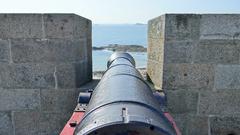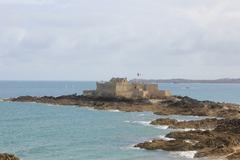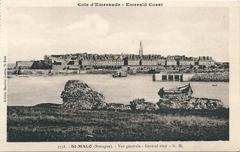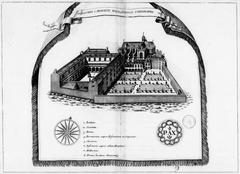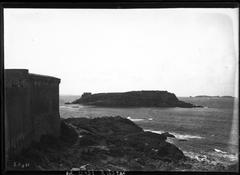Porte Saint-Thomas Visiting Hours, Tickets, and Guide to Saint-Malo Historical Site
Date: 14/06/2025
Introduction
Porte Saint-Thomas, set within the legendary walls of Saint-Malo, France, is a remarkable historical gateway that encapsulates the city’s rich maritime past and architectural prowess. As one of the principal entrances to the Intra-Muros—the walled old town—this iconic gate has witnessed centuries of military evolution, urban growth, and cultural resilience. From its 12th-century origins to Vauban-inspired enhancements in the 17th and 18th centuries, Porte Saint-Thomas exemplifies the robust defensive architecture that has come to define Saint-Malo (st-malo.com; cheminsdememoire.gouv.fr).
This comprehensive guide details everything you need to know for your visit: hours, ticketing (noting free access), accessibility, travel tips, nearby attractions, and the historical and cultural significance of Porte Saint-Thomas. Whether you are a history enthusiast or a traveler seeking a scenic and educational experience, Porte Saint-Thomas stands as a testament to Brittany’s enduring heritage (europeupclose.com; saintmalowithlove.com; monsieur-de-france.com).
Table of Contents
- Introduction
- Origins and Architectural Evolution
- Strategic and Historical Significance
- The Fortifications and World War II
- Cultural Heritage and Symbolism
- Visiting Porte Saint-Thomas: Hours, Tickets, and Accessibility
- Exploring the Ramparts and Nearby Attractions
- Tips for Visitors
- Events and Living Heritage
- Anecdotes and Local Legends
- Frequently Asked Questions (FAQ)
- Conclusion
- References
Origins and Architectural Evolution
Porte Saint-Thomas traces its roots to the 12th-century fortifications built under Jean de Chatillon, which marked Saint-Malo’s emergence as a formidable maritime stronghold (st-malo.com). The current structure is largely shaped by 18th-century renovations led by Siméon Garangeau, a follower of Vauban, whose influence is clear in the gate’s solid masonry and strategic positioning (cheminsdememoire.gouv.fr). This integration into the city’s ramparts—nearly 2 kilometers of granite walls—demonstrates the evolving needs of defense and urban life.
Strategic and Historical Significance
Throughout history, Porte Saint-Thomas played a vital role in Saint-Malo’s defense, especially during the 15th and 16th centuries under Duchess Anne of Brittany and during the city’s golden age of privateering. The ramparts and gates, bolstered by Vauban’s methods, were instrumental in thwarting English attacks during the 18th century, such as the attempted landings in 1758 (cheminsdememoire.gouv.fr). The gate enabled the rapid movement of soldiers, traders, and corsairs between the bustling port and the fortified city, contributing to Saint-Malo’s maritime culture.
The Fortifications and World War II
Saint-Malo’s fortifications, including Porte Saint-Thomas, endured the devastation of World War II. In August 1944, the city, occupied by German forces, suffered heavy bombardment, leading to the destruction of around 80% of its buildings (cheminsdememoire.gouv.fr). Remarkably, the ramparts—including Porte Saint-Thomas—survived largely intact, serving as enduring witnesses to the city’s resilience. Post-war reconstruction meticulously restored Saint-Malo’s historic character (europeupclose.com).
Cultural Heritage and Symbolism
Recognized as a Monument Historique since 1921, Porte Saint-Thomas is more than a relic—it is a living emblem of Saint-Malo’s identity as a “Corsair City.” The ramparts and their gates offer panoramic views of the English Channel, the port, and tidal islands, and are a focal point for both residents and visitors (cheminsdememoire.gouv.fr; evendo.com; saintmalowithlove.com).
Visiting Porte Saint-Thomas: Hours, Tickets, and Accessibility
Visiting Hours
- Ramparts and gate access: Year-round, typically from dawn to dusk; some sections may close during severe weather or special events.
- Guided tours: Available seasonally; check with the local tourism office for current schedules.
Tickets
- Entry: Free for all visitors to both Porte Saint-Thomas and the ramparts.
- Other attractions: Museums or forts nearby may require paid admission.
Accessibility
- General: The area around Porte Saint-Thomas is accessible, but the ramparts involve stairs and uneven surfaces.
- Mobility: Wheelchair users may face challenges; Porte Saint-Vincent offers a gentler incline.
How to Get There
- Address: 1 Place Vauban, Intra-Muros, Saint-Malo.
- Public transport: From the train station, Bus Line 1 (direction “La Richardais”) stops at Place Vauban, near the gate (evendo.com).
- Parking: Outside city walls at Parking Saint-Vincent or Parking Esplanade Saint-Vincent.
Exploring the Ramparts and Nearby Attractions
Porte Saint-Thomas is a convenient starting point for a full circuit of Saint-Malo’s ramparts (about 1.7–2 km). The walkway offers stunning views of Fort National, Sillon Beach, Grand Bé island, and the bustling port (st-malo.com; carnetsvanille.com).
Nearby attractions:
- Bastion de la Hollande: Features cannons and sea views.
- Plage de Bon Secours: Beach with tidal pool.
- Maison du Québec: Cultural center celebrating ties with Canada.
- Rue de Dinan: Lively shopping and dining street.
- Saint-Vincent Cathedral: Noted for its stained glass and architecture.
Tips for Visitors
- Best times: Early morning or late afternoon for fewer crowds and optimal lighting.
- Weather: Bring a jacket; coastal weather can be windy and changeable.
- Amenities: Cafés, shops, and public restrooms are close by in Intra-Muros.
- Safety: Wear sturdy shoes; ramparts can be slippery when wet. Supervise children and avoid climbing on the stonework.
Events and Living Heritage
Porte Saint-Thomas and the ramparts host events such as the “Route du Rhum” sailing race and the “Étonnants Voyageurs” literary festival (cheminsdememoire.gouv.fr). These events highlight Saint-Malo’s maritime spirit and cultural vibrancy.
Anecdotes and Local Legends
One local legend recounts the 1693 English assault, where an explosive ship intended to breach the ramparts detonated harmlessly, killing only a cat—hence the name “Rue du Chat qui Danse,” reflecting the city’s resilience and humor (st-malo.com).
Frequently Asked Questions (FAQ)
Q: Are there tickets required to visit Porte Saint-Thomas?
A: No, access is free.
Q: What are the visiting hours?
A: Generally from dawn to dusk, year-round.
Q: Is Porte Saint-Thomas wheelchair accessible?
A: Limited; steep stairs and uneven surfaces may restrict access.
Q: Are guided tours available?
A: Yes, through local tour operators or the tourism office.
Q: When is the best time to visit?
A: Early mornings or late afternoons outside peak summer offer the quietest experience.
Visual Highlights
Alt text: Porte Saint-Thomas entrance with granite walls and flanking towers in Saint-Malo Alt text: Panoramic sea and port views from the ramparts near Porte Saint-Thomas
Practical Information
- Public restrooms: At Place Châteaubriand and near Porte Saint-Vincent.
- Shops and restaurants: Abundant in Intra-Muros, especially along Rue de Dinan.
- Safety: The ramparts are unfenced in some areas—supervise children.
- Pets: Dogs are permitted on a leash.
- Emergency contacts: Tourist Office +33 (0)2 99 56 64 48; Police 17; Medical Emergency 15.
Suggested Itineraries
- Short visit: Enter via Porte Saint-Thomas, walk to Porte Saint-Vincent, enjoy a coffee at Place Châteaubriand.
- Half-day: Combine ramparts with Château de Saint-Malo and Intra-Muros exploration.
- Full day: Add a low-tide walk to Fort National and local dining.
Call to Action
Plan your visit to Porte Saint-Thomas and immerse yourself in Saint-Malo’s storied past. Download the Audiala or Navaway app for guided tours, maps, and event updates. For more inspiration, consult the Saint-Malo Tourist Office and follow local tourism channels.
Summary and Recommendations
Porte Saint-Thomas is a must-see for anyone exploring Saint-Malo. Its free access, panoramic views, and historical significance make it an essential stop along the city’s ramparts. While the historic nature of the site presents some accessibility challenges, guided tours and audio guides can enrich your visit. Combining Porte Saint-Thomas with other nearby attractions will provide a comprehensive experience of Saint-Malo’s maritime heritage (cheminsdememoire.gouv.fr; saintmalowithlove.com; monsieur-de-france.com; europeupclose.com; carnetsvanille.com).
References
- Porte Saint-Thomas: Visiting Hours, Tickets, and Historical Guide to Saint-Malo’s Iconic Gate, 2024, (st-malo.com)
- Saint-Malo Historical Fortifications, 2024, (cheminsdememoire.gouv.fr)
- Saint-Malo Post-War Reconstruction, 2024, (europeupclose.com)
- Exploring Saint-Malo: Complete Illustrated Guide, 2024, (saintmalowithlove.com)
- Saint-Malo Visitor Information and Ramparts Tour, 2024, (monsieur-de-france.com)
- Saint-Malo Medieval Urbanism and Ramparts, 2024, (archdaily.com)
- Saint-Malo Tourism and Ramparts Walk, 2024, (saint-malo-tourisme.co.uk)
- Saint-Malo Travel Tips and Visitor Guide, 2024, (carnetsvanille.com)
- Saint-Malo Visitor Experience and Practical Information, 2024, (cityzeum.com)
